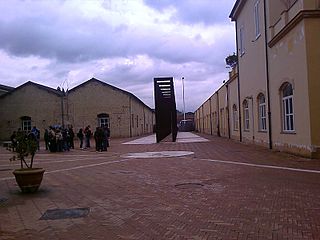 W
WThe Garden of Archimedes is a museum for mathematics in Florence, Italy. It was founded on March 26, 2004 and opened its doors to the public on April 14 of that year. The mission of the museum is to enhance public understanding and perception of mathematics, to bring mathematics out of the shadows and into the limelight. It has been compared to the National Museum of Mathematics in New York City, the only museum in North America devoted to mathematics.
 W
WThe Chieti Museum of Biomedical Sciences is a medical museum, located in Chieti, Abruzzo. It was established in 1994 at Palazzo De Pasquale, promoted by Luigi Capasso. D'Annunzio University assumed governance of the Museum in 2010.
 W
WThe Città della Scienza is a museum in Naples, in Campania in southern Italy. It was opened to the public in 1996 and features various areas in which one can explore and learn about science, natural phenomena, and hosts a wide large number of science exhibits and culture events. It is also a promoter for sustainable technologies activities and enterprises. Its structures are located in Bagnoli, the ex industrial district in Naples, and its nucleus was built in a 19th-century workshops industry archeological site.
 W
WThe Domus Galilaeana is a cultural and scientific institute and library, dedicated to the history of science, located in via Santa Maria #26, in Pisa, region of Tuscany, Italy. Currently, the Domus Galilaeana houses a library with more than 40,000 books and important files appertaining to scientists of the 20th century.
 W
WThe Museum and Mausoleum of Guglielmo Marconi is a museum and burial structure for the Italian scientist, inventor, and engineer, Guglielmo Marconi. The tomb is located adjacent to the 17th-century Villa Griffone/Villa Marconi, located on via Celestini #1 in Pontecchio Marconi, about 15 kilometers outside the city of Bologna in Emilia Romagna, Italy.
 W
WMuseo Nazionale Scienza e Tecnologia Leonardo da Vinci in Milan is the largest science and technology museum in Italy, and is dedicated to Italian painter and scientist Leonardo da Vinci. It was opened on 5 February 1953 and inaugurated by the prime minister of Italy, Alcide De Gasperi.
 W
WThe Museo delle Industrie e del Lavoro del Saronnese in Saronno is a science and technology museum, displaying industrial heritage strictly related to the industries in the area of Saronno town, north of Milan. It was opened on 25 October 1998.
 W
WThe Museo delle Scienze (MUSE) is a science museum in Trento, Italy. The museum was designed by architect Renzo Piano and opened in 2013.
 W
WThe Museum of Human Anatomy Luigi Rolando is a museum of human anatomy that was founded in 1739 with headquarters in Torino, Italy. It is part of the museum network of the University of Turin and moved to its current location in the Building of the Anatomical Institutes in 1898.
 W
WThe Tempio Voltiano is a museum in the city of Como, Italy that is dedicated to Alessandro Volta, a prolific scientist and the inventor of the electrical battery. Volta was born in Como in 1745, held his first professorship there until 1779, and retired to Como in 1819.
 W
WThe Tribune of Galileo is a Neoclassic architectural addition, built to commemorate the famous Florentine scientist, Galileo Galilei and to house some of his scientific instruments.
 W
WThe University History Museum of the University of Pavia is a museum displaying memorabilia related to the history of the university, particularly in the fields of physics and medicine, when students were taught by prominent scholars such as Antonio Scarpa and Camillo Golgi or the physicist Alessandro Volta.